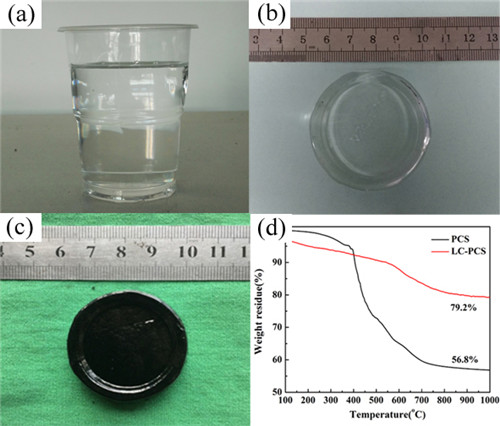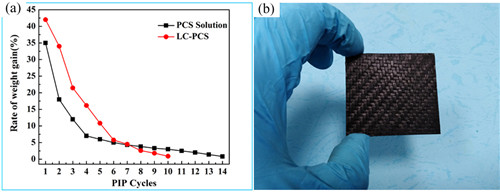Precursor transformation of silicon carbide ceramic matrix composites (CMCs) is mainly used to prepare excellent properties such as high temperature resistance, oxidation resistance, good wear resistance, low thermal expansion rate, good electrical and thermal conductivity, high hardness, and corrosion resistance. Net size molded high-performance ceramic materials and fiber-reinforced ceramic matrix composites; now widely used in high-end technology and defense military fields, such as space remote sensing imaging optical system lightweight support structures, aerospace engine hot end components, repeatable Used space vehicle thermal protective materials, hypersonic transport propulsion systems, etc. In the civil sector, precursor structural transformation materials also gradually reflect its enormous economic value and irreplaceable role, such as brake systems for modern transportation systems such as aircrafts, high-speed railways, automobiles, hot-end components of high-temperature gas turbines, waste heat recovery of high-temperature gases, and industrial dust filtration. , corrosion-resistant renewable catalyst carrier, large-scale high-temperature system heating components, metallurgical high-temperature furnace with carbon sleeve. With the further advancement of civil-military integration, the transformation of precursors into high-performance structural ceramic materials will become more green and cost-effective. Their products will be more widely used in all aspects of the economic and social system, and will promote economic development. The role will be greater and greater. The preparation of precursors of the CMCs matrix is ​​crucial. From the process flow, the ideal precursors should have both “three lows†(low viscosity, low temperature cross-linking, low shrinkage) and “two nos†(no impurities, no foaming). ), "A high" (high ceramic yield) characteristics. At present, Cf/SiC and SiCf/SiC systems have developed the most rapidly in CMCs, and solid polycarbosilanes (PCS) have been used as precursors of SiC in China. The disadvantages are: they need to be dissolved in organic solvents, and the impregnation efficiency is reduced. Contamination; PCS itself cannot be cross-linked, foaming after pyrolysis; PCS ceramics yield is not high, about 55%; the price is more expensive, 3000 ~ 4,000 yuan / kg. At the same time, the best service temperature of SiC-based composites is around 1600°C. For the service temperature of 1000-1300°C, the materials can meet the application requirements, but it will cause redundancy. Excessively high production costs limit the expansion of its application range and mass production, such as high-temperature structures, heat-resistant components, high-temperature chemical pumps, valve applications, etc., and there is an urgent need to find cost-effective alternatives. Through the LC3 program, the United States first carried out research on the cost of CMCs, identified SiOC-based systems that were suitable for temperatures below 1300°C, and developed precursor products for PIP processes. The Nuclear Energy Materials Engineering Laboratory of Ningbo Institute of Materials Technology and Engineering, Chinese Academy of Sciences undertook the special task of nuclear energy piloting of Chinese Academy of Sciences during the “Twelfth Five-Year Plan†period, and conducted in-depth research on high-performance silicon carbide precursor materials. In the preparation of pre-polycarbosilanes, it was found that a large number of small-molecule liquid by-products were generated during the conventional synthesis process. Recently, under the guidance of the research ideas of green manufacturing and cost reduction, the team conducted research on the reuse of the above liquid by-products. In this study, the laboratory scientists analyzed the composition of the liquid by-products and determined that it was a liquid low molecular weight PCS with a weight-average molecular weight between 200 and 800 and a Si-C backbone. Further, a "C=C" active group was introduced therein to prepare a liquid precursor (LC-PCS) that can be converted into a SiOC ceramic. LC-PCS has the following characteristics: 1 room temperature viscosity of about 30mPa · s; 2 can fully crosslink below 400 °C; 3 ceramic yield greater than 70%. Finally, the precursors of LC-PCS and PCS were used to prepare CMCs by PIP process. The results show that the "impregnation-cracking" cycle required to obtain dense samples is reduced from 14 to 10. It can be seen that the new synthesis route reduces the cost of CMCs from both the precursor itself and the composite material preparation process, and prepares cost-effective CMCs that can be serviced at 1000-1300°C. The reuse of liquid by-products also enables the green synthesis of PCS, reflecting the environmental benefits. The research results paved the way for military and nuclear high-end materials to enter the civil sector. Ningbo Institute of Materials has patented the green and low-cost technology (201810433805.3) and actively promoted the docking of downstream products. The above work was supported by the support of the National Natural Science Foundation of China (91426304) and the Chinese Academy of Sciences' Strategic and Pilot Science and Technology Project (XDA03010305). Compact Ball Valve,Upvc Compact Ball Valve,Compact Ball Valve Thread,Pvc Compact Ball Valve Thread Zhejiang Huangyan Minghua Plastic Pipe Fitting CO.,LTD , https://www.pipefitting-mh.com
Figure 1 (a) LC-PCS; (b) crosslinked cured product; (c) 1200°C lysate; (d) TG curves for PCS and LC-PCS 
Figure 2 (a) LC-PCS and PCS solution impregnation cycles - weight gain curves; (b) LC-PCS precursors 2D Cf/SiOC
Ningbo Materials Co., Ltd. takes the research and development of green and low-cost technologies for silicon carbide composites.